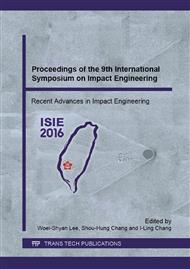p.63
p.68
p.74
p.80
p.86
p.95
p.101
p.107
p.111
Experimental Study of the Effects of Geometry and Strain Rate on Dynamic Behavior of Axial Crushing Honeycomb
Abstract:
The axial crushing behavior of some metal honeycombs, of which materials show different characteristics including the strain rate sensitivity with each other, was studied with varying the branch angle at the node of honeycomb, and the effects of geometry and strain rate on that as an energy absorber were discussed. Honeycomb specimens of different branch angles were made by the corrugation technique, and axial crushing tests were carried out under low-speed and impact loading conditions. Then, the effects of the characteristics of stress – strain relation of the material itself, the branch angle and the strain rate on the stress – strain relation of honeycomb structure and the mean buckling stress were examined. The tendency of deterioration in the plateau load or the mean buckling stress due to the irregularity of branch angle was evaluated with considering the influence of boundary conditions by the aid with the numerical simulation. It was also found that the strain rate dependence of metal honeycomb is greatly relaxed as compared with that of the material itself.
Info:
Periodical:
Pages:
86-92
Citation:
Online since:
September 2016
Authors:
Keywords:
Price:
Сopyright:
© 2016 Trans Tech Publications Ltd. All Rights Reserved
Share:
Citation:


